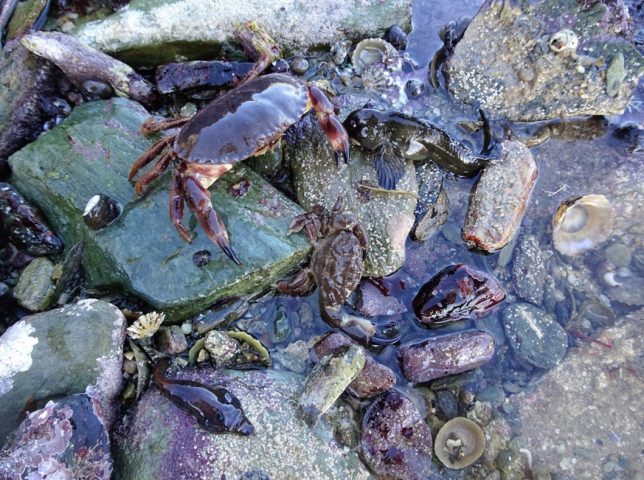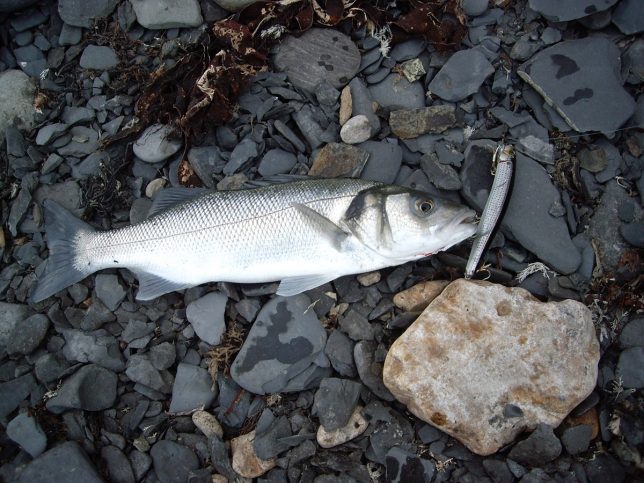Food Rich Lagoons by Marc Cowling
Not to be confused with a harbour containing mud flats and the like, the official definition of a ‘lagoon’ is a stretch of water separated from the sea by a sandbank or reef – which is precisely what these bass ‘food stores’ are. The specific bass marks that I’ve portrayed so far will have a multitude of ‘critters’ hiding amongst the rocks, weed, pools, sand/mud or will represent evident havens for bass to swim, hunt and ambush (patrol and position essentially). Moreover, two facets that they have in common is they are all very ‘open’ or exposed to the elements (waves/tide) and will invariably be submerged for extended periods over the cycle of tides. A lagoon, on the other hand, is somewhere that might only be ‘available’ to hunters such as bass, wrasse, pollack, conger and a multitude of mini species (bass prey) for a fraction of the time, in addition to being protected from the fiercest tides and stormiest seas – herein could be the fascination.
Like many components associated to bass lure fishing – once you think logically about some of the processes (where and when especially) things actually begin to make a little bit more sense. For example, the lagoons that I have discovered so far are, quite simply, a veritable banquet of bass food! The amount of ‘life’ present is astounding, as almost every A3+ size rock I turn over will have half a dozen crabs beneath it and a blenny, squat lobster or suckerfish for good measure. Find a rock that is dug into a patch of gravelly mud and sure enough, you’ll unearth another couple of crabs and a huge ragworm or lugworm
These marks are also very shallow (an average of 18”-4’) and only fully submerged for maybe 1½-2 hours either side of high water. Further, they are either completely isolated from the open sea or with only a couple of narrow culverts trickling into them (albeit to the open sea) outside of these tidal parameters. It is my belief that the added protection from the elements, coupled with the fact that predators can only access these areas for short periods in the tide that overall, could be the reason these lagoons are so food rich. And if there is one species of sea fish that can take full advantage of feeding within this sort of terrain it is, without doubt, a bass. Not so well known perhaps, is that wrasse (especially the larger specimens) will also hunt across long distances and into such areas.

There is also a secondary theory which augments my suggestion that if you can find them, these are potentially fantastic and consistent bass marks… All of that ‘life’ has a shortened timescale in which to conduct their own hunting and feeding, therefore, across the lagoon, there will be a very condensed flurry of activity involving all the prey items bass love to eat. The opportunity for a shoal of marauding bass to venture into an area that is literally teeming with life, that are also highly active and potentially out in the open, must be irresistible… The following short story describes my initial ‘discovery’ of such a venue and is the sort of place that I would have walked straight past up until a few years ago…
“I’d been eying up this mark for some time – a lunar landscape, the size of half a football pitch and that is only flooded with sea water over the top two hours of an average sized high tide (4.7m Salcombe scale). To complement its obscurity, there is an outer rim of rocks and two diminutive gullies connecting this bowl-shaped oasis with the ferocious current of an adjoining and very prominent headland.
Confirmation that it was brimming with life had been conducted on a cold winter’s day (when much of my exploration is completed) to the extent that I’d found dozens of gobies, blennies, rockling and even a peeler crab in mid-February!
It was now May, and with the tide creeping into the lagoon – but as it was the first time I’d fished this mark I just sat and watched for the first thirty minutes or so before I considered that the water was deep enough to cast a lure into. In many of the rock pools there were groups of what I believe were immature mullet or bass – either way, they were grey backed with a shimmering side/belly. Stranded for now, within the next hour they would be able to swim out of the pools as the tide flooded into them, which caused me to ponder whether the bass would also be aware of this occurrence.
As the water level rose, the cloud cover increased and an onshore breeze developed which although wasn’t strong enough to cause any real waves, the surface of the water became rather choppy – excellent additional cover for the bass angler I thought… By now, the water was between 30-50cm deep with a scattering of the larger boulders present just about protruding above the surface. Clipping on a Tacklehouse Feedshallow 128 (Mullet colour) I crept along the base of the rocks, keeping as low as I possibly could and began to make some casts – close in initially just to see if any bass were positioned within the margins.
On about the tenth retrieve I’d just started winding when I felt a ‘bump’ or ‘knock’… probably a rock or frond of weed… But within two more turns of the reel handle there was an almighty boil 15m out and the rod hooped over – but was it a bass or a wrasse? A strong pulling sensation reverberated down the lure rod and the tightly set drag allowed a metre of line to be pulled from the spool. There! A flash and the braid slicing through the waves as the fish made a spirited run towards one of the boulders confirmed my suspicions of the potential of this mark. Yes! It was a bass! Applying some side strain, I managed to turn the fish, which by now I realised wasn’t a monster, but a respectable size all the same. Steering the fish into a patch of stones and gravel, this 3lb bass was the first of five (ranging from 2-3lb) that I managed over the top of the tide all on the same lure.”
It was around this time that I started to keep very detailed records of my sessions (both the successful trips and the blanks) and looking back over these notes there are so many insightful aspects as to why I think I managed to catch those bass in relatively quick succession, such as:
- As mentioned – the amount of food present was exceptional.
- There was the added bonus of groups of immature fish being present.
- I was using a proven lure, suited to the terrain (very shallow diving) that was the same shape, size and colour of the ‘stranded fish’ – the mullet or small bass.
- The cloud cover and choppy sea conditions would have helped to encourage the bass into the lagoon.
- I believe I was catching bass that formed part of the same shoal.
- The knock or bump was a bass hitting the lure (and trying to stun the little fish) with its gill plates – something they have a penchant for when attempting to disable their prey.

It goes without saying that I’ve returned to this particular lagoon many, many times and it is a very interesting mark. When the conditions are bright and sunny, not surprisingly perhaps, you have a 70% chance of catching a wrasse rather than a bass. Yet any dullness or movement to the water will flip those odds, therefore, conditions have a huge part to play. In more recent times, I have fished this particular mark with lures in complete darkness for bass – each time in very calm, clear sea conditions. Moreover, I have to say that up until this point in time it has been the most dependable ‘night mark’ that I’m familiar with. What’s more, the bites (and fish) seem to arrive in clusters and the bass landed have varied in size from 1lb to 6lb depending, I believe, on the size of the shoal that is moving out of the neighbouring tide race, in through those narrow channels in order to gorge themselves within a brief window of opportunity, before moving off and out into the tide again – something that I now understand is typical bass ‘movement and behaviour’.
This post is based around an excerpt from ‘The Lure Of The Bass’ by Marc Cowling.
Read a review of ‘The Lure Of The Bass’ published in BASS Magazine no.161 Winter 2018/19.